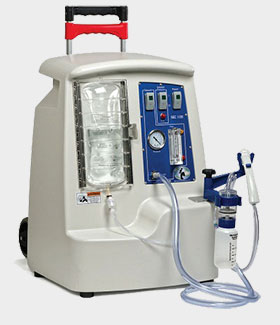
M-Vac DNA Collection – An innovative DNA collection method available at Advanced Serology Laboratory

Suzanna Ryan,
MS, D-ABC
Owner/Consultant at Ryan Forensic DNA Consulting.
What is it?
The M-Vac is a wet vacuum system originally developed for use in the food industry to sample food for possible pathogens. However, the developers of the system realized that with some minor tweaking this system could also be a huge benefit in the collection of forensic DNA evidence.
The M-Vac can be thought of as a miniature hand-held carpet cleaner. However, instead of spraying a cleaning solution, the sampling head sprays nuclease-free, DNA-free, sterile buffer onto the item of interest. As the buffer is sprayed, DNA present on the surface of the item is released from the substrate and is vacuumed up by the constant vacuum that is simultaneously applied by the sterile, single-use sampling head.
Once the item is sampled, the liquid, which will contain DNA from the substrate and is captured in a collection bottle, is transferred to a sterile Nalgene 0.45micron filter and allowed to filter through under vacuum pressure. The 0.45micron filter allows the water to filter through while capturing the DNA on surface of the filter. Once dried, the filter can easily be removed from the Nalgene filter apparatus and can be further processed for DNA using the same techniques as cuttings or swab samples.
Why use it?
You may be asking yourself, why should you consider using this admittedly more expensive collection method over traditional swabbing, taping, or cutting techniques? Some of the reasons for using the M-Vac are:
- Studies have shown that the M-Vac is better at collecting DNA than swabbing, cutting, or taping. Internal validation studies by the Washington State Patrol, for example, showed that in comparison to swabbing, the M-Vac was able to collect anywhere from 36% to 189% more DNA from experimental evidence items such as extremely dilute blood (1:5000 – 1:25,000) on shirts, rocks, and wood and from touch DNA on knit caps and duct tape.
- With the M-Vac, one can process larger areas as a single sample as compared to cutting or even swabbing. For example, large areas of clothing items can be processed in an attempt to find any “touch” DNA from an assault victim. Or, entire lengths of rope, rocks, or bricks can be sampled and processed as a single sample. This would simply not be possible with cutting, taping, or swabbing methods.
- Difficult to swab items, like rocks and bricks, can be easily sampled with the M-Vac. In fact, the M-Vac excels in collection of DNA from rough and porous substrates.
- Items that have already been swabbed by the laboratory can be re-sampled with the M-Vac system with successful results. This means that if you have an item of evidence that has already been tested by your state or county laboratory, you may be able to have the same item re-tested with the M-Vac, whose superior DNA collection abilities may result in a usable and probative DNA profile. This can be especially useful for cold cases where evidence that was previously tested can now be re-examined using the M-Vac system for collection in conjunction with the extremely sensitive DNA testing techniques in use in today’s forensic biology laboratories.
- The M-Vac has been shown to be successful in collecting trace amounts of male DNA on items owned or worn by females. Used in combination with Y-STR testing, large areas of female’s clothing can be sampled into a single filter and anywhere that the male suspect came into contact with the clothing could potentially yield male DNA. A forthcoming study from UC Davis is expected to illustrate the ability of the M-Vac to collect male touch DNA from clothing items worm by victims of simulated assaults. In actual casework, the M-Vac has already been successfully used to collect trace “touch” DNA from the underwear of a female child homicide victim who had been partially submerged in water for up to 10 hours.
- The M-Vac can even be used on human skin when a specialized, vented, sampling head is utilized. One study, by UC Davis researchers, found that after saliva was applied to skin and dried, male DNA could be located on female DNA skin even after showering. This finding opens up a whole new avenue of DNA collection possibilities in sexual assault cases. This would be especially true in cases where the alleged victim may have been incapacitated at the time and does not have a clear recollection of where the perpetrator may have touched, licked, or kissed them and swabbing large areas is unrealistic. The M-Vac can be used to collect from the alleged victim’s entire arm, leg, torso, or other area in an effort to collect foreign DNA.
- The M-Vac system is mobile and can be taken directly to crime scenes in cases where collection of the item of evidence itself is simply impossible or impractical. The mobility of the M-Vac means that it can be taken to crime scenes, police stations, hospitals or rape crisis centers, among others, to collect evidence directly from items of evidence or from individual’s bodies.
Has it been used in actual casework and accepted in court?
The discussion above may lead some to wonder if the M-Vac has been successfully used on actual casework samples, and if so, have any of these cases been through the court system? The answer to both questions is a resounding, “yes!”. Success stories can be found on M-Vac’s website (www.m-vac.com) and involve homicides, sexual assaults,and cold cases. The murder of Uta von Schwedler, a University of Utah researcher, was solved in part due to the DNA results that were able to be obtained from a pillowcase though to be associated with the crime. The main suspect in the case was the victim’s ex-husband, John Brickman Wall, a pediatrician. Although a partial Y-STR profile was developed from the pillow, the suspect’s son also lived in Ms. von Schwedler’s home and, considering that the Y chromosome is passed unchanged from father to son, could have left the DNA behind. M-Vac testing was able to collect more DNA from the pillow and DNA testing was able to place an autosomal DNA profile consistent with the defendant on the pillow. The presence of this profile was more difficult to explain considering that Wall had not lived in the home for some time prior to Ms. von Schwedler’s murder and this evidence, along with other physical and circumstantial evidence was used to convict Mr. Wall of the murder of his ex-wife.
A second case, involving a 17-year-old cold case will be heading to trial in the very near future. The M-Vac was critical to the success of solving the case as the victim, Krystal Lynn Beslanowitch had been bludgeoned to death with a rock and the M-Vac was able to collect a full DNA profile matching the suspect from the rock.
What about validation? Should I be worried about contamination?
As the owner of a private laboratory that utilizes the M-Vac system, some police agencies have expressed concern to me that their laboratory may not accept the M-Vac collected sample since the system has not been validated by their state or county laboratory. However, as a former FBI-trained DNA laboratory auditor, it is my opinion that this should not be an issue for the lab as the M-Vac has undergone developmental validations to confirm that the reagents and consumables used are completely sterile and free of any nucleases or DNA. Beyond that, the M-Vac system is simply a DNA collection method. The samples produced are no different, in terms of extraction methodology, than any other collection method. Instead of a swab or swabs, the lab would simply be presented with a piece of polyethersulfone (PES) filter paper about the size of a half dollar. The filter can easily be cut into smaller pieces and placed in a standard 1.5ml tube for extraction purposes. The filter paper is amenable to nearly all types of standard manual or robotic extraction methods, with the sole exception of the organic extraction method which does not work well with the PES filter. The point is, however, that the lab does not have to do anything different when processing an M-Vac filter than when processing a cutting or a swabbing. If the lab is concerned about this type of sample, they could also refer to various other forensic laboratories who are using the M-Vac in their lab and have performed internal validations illustrating great success with the M-Vac. Those validations are available online and may at some point be published in a peer-reviewed journal.
Laboratories do not validate each type of new or different swab (of which there are many brands and types of swabs in use today) used by the many different agencies that submit DNA evidence to them, so there should be no expectation that a filter received by the lab for processing must first undergo a validation procedure prior to commencing with extraction of the sample.
Further, assuming proper operator precautions are taken, contamination is not an issue with the use of the M-Vac since the buffer, tubing, sampling head, and filter apparatus are completely sterile.
What kind of results will I get?
A concern that has been expressed in the past is that the M-Vac might collect “too much” DNA. Although I must admit I am not completely sure what “too much” DNA might be, I can understand a fear that the M-Vac might pick up extra DNA to the point that an uninterpretable mixture might be obtained. While that is certainly a possibility, just as it is with the swabbing technique, it is also now possible to interpret complex mixtures with the aid of probabilistic genotyping software. In addition, internal validations from various agencies have actually shown that in some instances the M-Vac can lead to higher-level mixtures that are interpretable versus low-level, uninterpretable, mixtures obtained with traditional methods.
The M-Vac is a fantastic new tool in the forensic arsenal and the more laboratories, police departments, and crime scene investigators that make use of this tool, the more the most challenging cases will be solved. The M-Vac is not right for every case, but it might just be the answer you are looking for with cases involving rough and porous items, items that are too large for swabbing, or items that have previously been tested. Have a look here at laboratory equipment for similar testing equipment and products that are also commonly used.